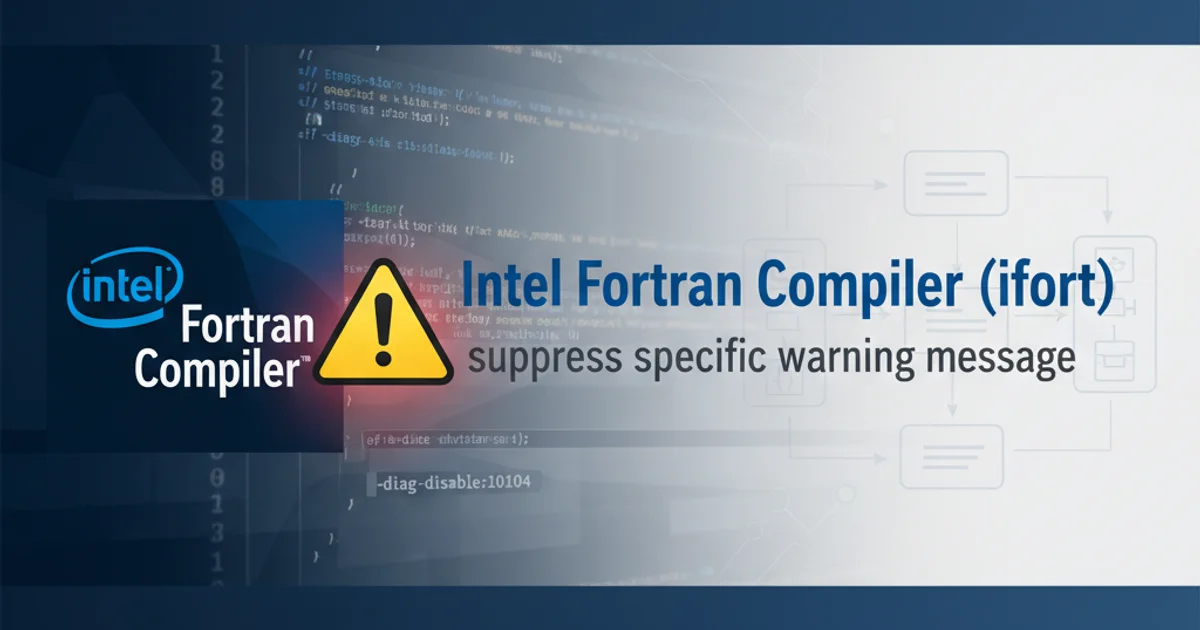Intel Fortran Compiler (ifort) suppress specific warning message
Categories:
Suppressing Specific Warning Messages in Intel Fortran (ifort)

Learn how to effectively manage and suppress specific warning messages generated by the Intel Fortran Compiler (ifort) to streamline your compilation process and focus on critical issues.
The Intel Fortran Compiler (ifort) is a powerful tool for developing high-performance Fortran applications. However, during compilation, it can generate a multitude of warning messages. While many warnings are crucial for identifying potential issues, some might be benign in specific contexts or relate to legacy code that you cannot immediately modify. Suppressing these specific warnings can help declutter your build output, making it easier to spot more critical errors and warnings.
Understanding ifort Warning Messages
Intel Fortran warnings often provide valuable insights into potential portability issues, non-standard language features, or inefficient code constructs. Each warning typically has a unique identifier, which is key to selectively suppressing it. For example, you might encounter warnings like remark #5149 or warning #10120. Understanding the meaning of these warnings is the first step before deciding to suppress them.
flowchart TD
A[Compilation Process Start] --> B{ifort Compiler}
B --> C{Source Code Analysis}
C --> D{Warning Generated?}
D -- Yes --> E{Warning ID Identified?}
E -- Yes --> F{Decision: Suppress?}
F -- Yes --> G[Add -diag-disable:ID to ifort options]
F -- No --> H[Review and Address Warning]
E -- No --> I[Investigate Warning Message]
G --> J[Continue Compilation]
H --> J
I --> J
J --> K[Compilation Process End]Workflow for identifying and suppressing ifort warnings
Methods for Suppressing Warnings
Intel Fortran provides several command-line options to control warning messages. The most common and precise method for suppressing specific warnings is using the -diag-disable option, followed by the warning's identifier. You can also disable entire categories of diagnostics, though this is generally less recommended as it might hide important issues.
Using -diag-disable for Specific Warnings
The -diag-disable option allows you to disable one or more specific diagnostic messages. You provide the diagnostic ID (the number) after the option. If you need to disable multiple warnings, you can either repeat the option or provide a comma-separated list of IDs.
# Disable a single warning (e.g., remark #5149)
ifort -diag-disable:5149 my_program.f90 -o my_program
# Disable multiple warnings (e.g., warning #10120 and remark #5149)
ifort -diag-disable:10120,5149 my_program.f90 -o my_program
# Alternatively, repeat the option for multiple warnings
ifort -diag-disable:10120 -diag-disable:5149 my_program.f90 -o my_program
Examples of using -diag-disable to suppress specific ifort warnings.
Other Diagnostic Control Options
While -diag-disable is for specific IDs, ifort offers other options for broader control over diagnostics:
-diag-error:id: Treats a specific warning as an error, causing compilation to fail.-diag-remark:id: Changes a specific warning or error to a remark.-diag-warning:id: Changes a specific remark or error to a warning.-diag-enable:id: Re-enables a diagnostic that was previously disabled (e.g., by a configuration file).-warn [keyword]: Controls categories of warnings. For example,-warn noalignmentsdisables warnings about data alignment issues. Use-warn helpto see a list of available keywords.-w: Suppresses all warning messages. This is generally not recommended for production builds as it can hide critical issues.
# Treat warning #10120 as an error
ifort -diag-error:10120 my_program.f90
# Disable warnings related to data alignment
ifort -warn noalignments my_program.f90
# Suppress all warnings (use with extreme caution!)
ifort -w my_program.f90
Examples of other ifort diagnostic control options.
IFORTFLAGS). This ensures consistency and avoids repetitive command-line typing.Identifying Warning IDs
To suppress a warning, you first need its ID. The compiler output typically includes this ID. If you're unsure, you can compile your code without any suppression options and carefully examine the output. The ID is usually a number preceded by # or (R) for remarks.
1. Compile your code without suppression
Run ifort on your source file(s) without any -diag-disable or -w options. This will show all warnings.
2. Identify the warning ID
Scan the compiler output for the specific warning message you wish to suppress. Note down the numeric ID associated with it (e.g., 5149, 10120).
3. Apply -diag-disable
Add the -diag-disable:ID option to your ifort command, replacing ID with the number you identified. Recompile to verify the warning is no longer displayed.
4. Document your decision
If you suppress a warning, it's good practice to add a comment in your build script or documentation explaining why that specific warning was disabled. This helps future developers understand the context.